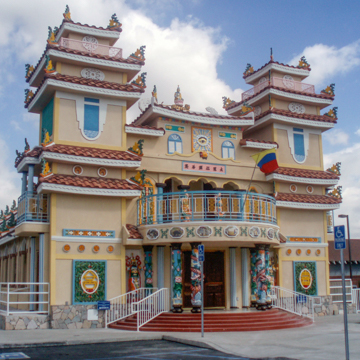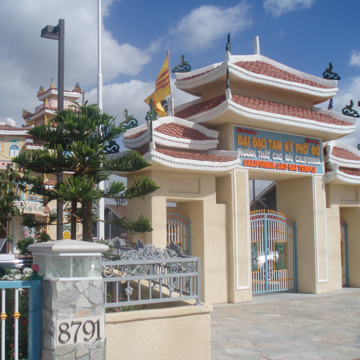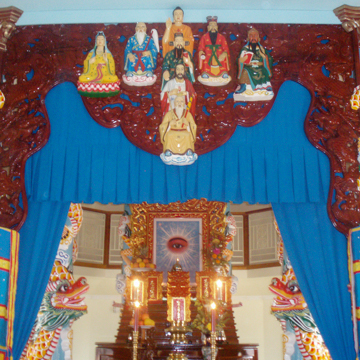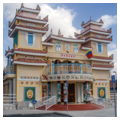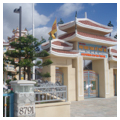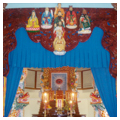The Cao Dai California Temple in Garden Grove was built by the Orange County congregation of Caodaists, which numbers about 25,000 people, and it is one of only four in the United States to be purposefully built following the sacred architectural blueprint of the Mother Church in Tay Ninh, Vietnam. Of U.S. counties, Orange County has the largest Vietnamese population (187,000 in 2010), and Garden Grove is one of several communities (including Westminster, Fountain Valley, and Santa Ana) identified as making up “Little Saigon.” The city of Garden Grove is 28 percent Vietnamese, while neighboring Westminster is over 40 percent Vietnamese. The temple is located in a residential area (where religious buildings are placed through zoning laws), and such areas are subject to many restrictions on the use of color, decorative accents, and unusual materials, which prolonged the process of obtaining a building permit.
Caodaism was founded in 1926 with the official name “The Great Way of the Third Era of Redemption.” Since 1930 it has been the third largest religion in Vietnam (after Buddhism and Catholicism) and there are roughly 4.4 million Caodaists in the world. Caodaists first came to the United States in large numbers after the fall of Saigon in 1975, and re-established congregations in California shortly after their arrival. This particular temple cost more than $2 million to build, despite the fact that many members of the religious community volunteered their time to help in the construction. The building permit was granted for a “Caodai Church” (perhaps because the front looks like a European Gothic cathedral), but it is more often referred to as a temple, while the actual Vietnamese name (Thanh Thầt) means “sacred house” in Sino-Vietnamese.
The temple’s design mimics those built in Vietnam, and combines many of the characteristics of Catholic cathedrals (such as a nave and apse) with the nine ascending levels of Buddhist pagodas, as well as aspects of the religious architecture associated with Taoism and ancestral temples. There is an eight-sided upper level, called the Bát Quai Đai, which is where the large elaborately carved wooden altar is placed. Ancestral tablets are arranged on top of this altar in front of a golden-framed image of the left human eye, “the sign of the divine,” which is considered the symbol of the Supreme God in Caodaism.
There are two towers on either side of the entry, which features five concentric steps that lead to the main door. A rather fierce and demonic human figure of evil, Ông Ác, is to the left of those who enter, while a more benevolent human figure of good, Ông Thiện, is on the other side. The left side also has images of the moon, while right side has images of the sun. Two stylized characters at the front of the temple spell out the name of the Supreme God—Cao Đài, the “highest power.” A large, curved balcony extends out above the entry area, and the tricolored flag of Caodaism, with saffron yellow at the top for Buddhism, turquoise in the middle for Taoism, and red at the bottom for Confucianism, is flown there. The emblem of the left eye is also seen above this balcony. A sculpted image of the Maitreya Buddha riding on a tiger sits atop the whole structure, signaling the final era of three great world eras, one that will end in the time of the dragon and flower, when the virtuous will be rewarded and given salvation. The tiger is a reference to the year Caodaism was founded, the year of the tiger.
The colorful features of the Cao Dai Temple form a “visual theology” representing the complex belief system, which combines Buddhism, Taoism, and Confucianism with elements of Catholicism (Jesus Christ is recognized as an important religious leader) and Spiritism. Caodai leaders see their syncretistic faith as the culmination of a spiritual evolution, which can encompass all other religions and move beyond contentious religious conflict. A pediment hanging from the ceiling just in front of the altar displays the five levels of spiritual attainment, which descends from the way of Buddha, to that of the immortals, to that of the saints, to that of local spirits, and then the way of humanity. The final day of reckoning is represented by the many pastel pillars surrounding the altar that feature dragons curled around them. On the other side of the worship center, facing the altar, is the character that stands for breath, the chi flow, which represents vital energy and human efforts. The inclusion of an Islamic-style minbar, images of Brahma, Shiva, Vishnu, and Jesus Christ at the third level of spiritual attainment show how this theology is expressed through visual imagery.
References
Hoskins, Janet Alison. The Divine Eye and the Diaspora: Vietnamese Syncretism Becomes Transpacific Caodaism. Honolulu: University of Hawaii Press, 2015.
Hoskins, Janet Alison. “A Spirit Medium as Architect: Caodaism’s Visual Theology.” In The Spirit of Things: Materiality in the Age of Religious Diversity in Southeast Asia, edited by Julius Bautista, 43-60. Ithaca: Cornell University Southeast Asian Publications, 2012.

